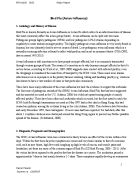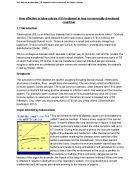2. Diagnosis, Prognosis and Demographics
The H5N1 Avian Influenza virus once contracted is likely to have an effect of the victim within a few days. Within the first three days the symptoms are minor and very basic similar to that of a common cold, such as sore throat, high fever and coughing up high levels of mucus, and muscle pains and headaches, yet these are some of the common signs of Bird Flu (SD Bird Flu.org, 2006 - 2011). After the victim has been exposed to the poultry that has the disease is a carrier. The incubation period is approximately 7 days or less mainly between 2-5 days. These symptoms rapidly develop in seriousness within a couple of days, according to the (New England Journal of Medicine) from the time you catch the disease to the presentation (median 4 days) or leading to death (median 10 days), has remained the same since 2003 to 2006 ( Eng. J Med, 2008). In February 2008, the median age of the infected victims with the (H5N1) strand is approximately 18 years of age and the fatalities have remained a stable 61%. Those most at risk are those suffering from asthma or respiratory problems and elderly people who have trouble breathing leading to difficulty in breathing (Wilson, date accessed 15/5/2013). The Avian Flu after having entering the human body attacks the cells especially the respiratory cells, they usually implant themselves in other host cells and reproduce and divide destroying the host cell and using the copies to spread to other cells meaning that it spreads very fast in the human body(FOA.ORG, date accessed 15/5/2013).
The (H5N1) Influenza virus also destroys muscle cells in the lungs making it very hard for sufferers to breathe, especially for those that already suffer respiratory diseases such as asthma making it difficult to breathe without assistance of ventilators. The (H5N1) contains 8 genes meaning it could mutate easily with the DNA of other diseases as had happened with avian flu which mutated with human strands of influenza, which have led to some severe and rare cases to which have stood out as long term effects such as of damage on muscle cells on the lungs (Wilson, date accessed 15/5/2013), but there is very little evidence apart from some cases to support these suggested long term effects. The full understanding of short and long term effects are still unknown.
3. Treatment and Prevention
The Avian Influenza has of yet no cures that have been produced that are 100% effective against this disease due to (H5N1) ability to mutate at a rapid rate. (News Medical, date accessed 15/5/2013). Health officials recommend that the victim use Oseltamivir (Tamiflu) which can inhibit (H5N1) virus strand from spreading inside the individual’s body. There are also studies of a new drug that may also be effective, the Relenzna (Zanamivir) drug which is a similar drug like the (Tamiflu) may be effective to minimize the effects of the (H5N1) (Mayo Clinic, 2013). There is no cure for the Avian Influenza, but there are many methods to minimize and prevent the chances of catching the bird flu.
Also health officials in the United States, Europe and UN are helping Asian countries in working to stop the spread of flu and to control it, steps such as below are being taken-
- Issuing vaccines to people that handle poultry, although the vaccine might not be effective in preventing the disease, it could help minimize chances of spreading.
- Providing cleaner equipment to use when dealing with poultry.
- They also have set up a program to minimize wild birds mixing with domestic birds as the wild species are the carriers (Flu. Gov., date accessed 15/5/2013).
Some precautions to minimize the chances of getting this disease are report sick or dead birds to the local veterinary if possible. Keep birds at a distance from family living areas. Try not to capture and eat wild birds. If handling poultry always wash hands thoroughly to kill any virus or your hands, in case there may have been an infected bird. And eat poultry that has been well cooked (FOA.ORG, date accessed 15/5/2013).
4. Global Health – Recent Outbreak
An outbreak of Avian Influenza has been documented to have been most severe between the years 2003 – 2007. In Jan. 5 2003 the first outbreak occurred in Hanoi (Vietnam) were the World Health Organization (WHO) offices that were notified of the severe respiratory problems amongst 11 young children that had been hospitalized. Jan. 14 – WHO notifies for urgent assistance to aid the (WHO) organization in Hanoi. Towards the end of January 26 have been found dead or either been destroyed, ban on all Thai poultry. Vietnam reports that 23 of the country’s 64 provinces, approximately 3 million chickens have either been destroyed or killed by the Avian Influenza virus in Vietnam.
December 2003 Leopards and Tigers at the Thailand zoo die after eating fresh poultry (Chicken) that had un-knowingly been affected with the (H5N1), it had been the first time that this virus had been seen in these large felines, this had sparked major concern as to how serious this virus in fact been. And continue to spread through domestic cats due to the cat food containing chicken and duck. Feb. 2 2005 news that Cambodia has reported that an individual that had been infected was seriously ill (Ling Yen et al., 2008) November 2005 China has been reported to have quarantined 116 individuals
January 2006 the avian flu has been reported by (WHO) to have spread to Turkey infecting 14 people, UN experts say there is little to no evidence stating the Avian Flu is spreading between humans (Adam, 2006).
As of August 2007, there were a total of 322 confirmed human cases of the virus with confirmed deaths 195. In all the countries that have been affected Indonesia has the still standing highest amount of fatalities across the world at 84 (Hanson et al., 2007). There have been many strategies taken after the worst of the Avian Influenza including cleaner hygiene such as washing hands, cleaning the bird droppings regularly, and most importantly not mixing wild birds with domestic birds, and cooking poultry thoroughly.
References and Bibliography
Adam, M. (Feb. 06. 2006) A History of Influenza. Natural News via: www.naturalnews.com , accessed may 2013.
Agriculture Department (2013) Animal production and Health Division, via: , accessed may 2013.
Avian Flu (2013) H5N1 Avian Flu (H5N1 Bird Flu) via: , accessed 15 may 2013.
Chen, H,. Bu, Z,. Wang, J,. Epidemiology and control of H5N1 Avian Influenza in China. Karger, vol. 27, pp. 11 - 26.
Hanson, D. (2007) Australia’s Preparation for a Human Influenza Pandemic. Australian National Audit Office, Australia, pp. 37 - 40.
Mayo Clinic (2013) Bird Flu (avian influenza) via: www.mayoclinic .com, accessed 15 may 2013.
Med (2008) England Medical Journal, vol. 8.
Munster, J. V, (2008) Epidemiology of Avian Influenza, Karger, vol. 27, pp. 1 – 10
News Medical (2013) Bird Flu (H5N1) Treatment. Via: – medical.net, accessed may 2013.
Scholtissek. C,. (2008) History of Research on Avian Influenza. Karger, vol. 27, pp. 101 – 117.
SD (2008) Bird Flu, vol. 126
Wilson, T. V, (2008) How Bird Flu Works, via. Science.howstuffworks.com, accessed may 2013.
Yen, L. H,. Guan. Y,. Peiris. M,. Webster. R. G., H5N1 in Asia, Karger, vol. 27, pp. 11 – 26.
Daniel Pazeski
Student no. c3187927









